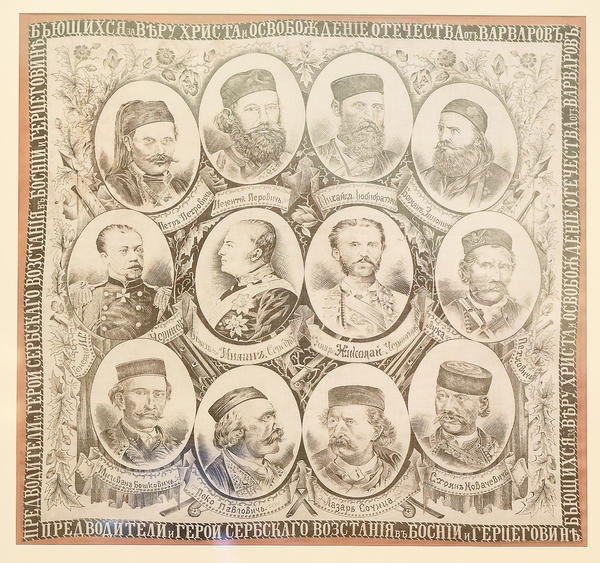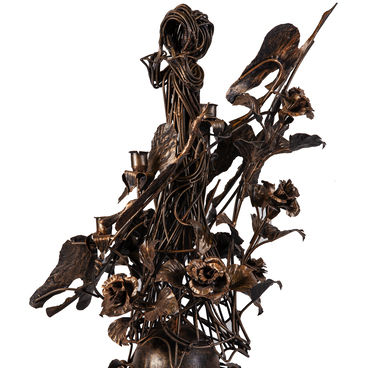This ornamental scarf depicts the key figures of the Bosnia and Bosnian- Herzegovina people’s liberation uprising against the oppression of the Ottoman Empire, which took place in 1875-1878.
The uprising was triggered by the increase in the tithe amount. The main driving force behind the uprising was the peasants. A revolutionary-democratic group established under the leadership of Vaso Pelagic represented their interests with the craftsmen, the bourgeoisie and even intellectuals supporting them.
The protesters demanded the transfer of all land to the peasants, the unification of Bosnia and Herzegovina with Montenegro and Serbia, as well as a transition to a democratic state system.
The armed uprising began on July 5, 1875. Near the town of Nevezine, a squad of Hayducks attacked a Turkish caravan. A month later, the number of insurgents grew to about 10 - 12 thousand people with the protests spread over most of Herzegovina and several areas of Bosnia.
The rebels blocked several big cities and Turkish fortresses, captured Tiskovac, the stronghold of the Ottomans. In October 1875, the Main Committee of the Bosnian Uprising for Liberation was established in Nova Gradiska, which began to coordinate the actions of the rebel groups.
Some European countries supported the uprising, providing, among other, financial assistance. Rebel aid committees first appeared in Croatia, Montenegro and Serbia, and August 1875 witnessed the establishment of the International Uprising Relief Committee in Paris.
One of the main goals of Russia’s foreign policy at that period was to help Bosnia and Herzegovina gain autonomy. Numerous Russian volunteers were sent to help the rebels.
The uprising precipitated the onset of the first Bosnian crisis. In 1876, Montenegro and Serbia declared war on the Ottoman Empire. The Bosnian rebels also participated in all military operations of the Montenegrin army.
According to the decision of the Berlin Congress, Serbia and Montenegro gained sovereignty as a result of the war. Austro-Hungary occupied Bosnia and Herzegovina, which formally remained part of the Ottoman Empire. The Austrian troops entered the territory of Bosnia and Herzegovina in the summer of 1878 and soon completely suppressed the liberation uprising.
The uprising was triggered by the increase in the tithe amount. The main driving force behind the uprising was the peasants. A revolutionary-democratic group established under the leadership of Vaso Pelagic represented their interests with the craftsmen, the bourgeoisie and even intellectuals supporting them.
The protesters demanded the transfer of all land to the peasants, the unification of Bosnia and Herzegovina with Montenegro and Serbia, as well as a transition to a democratic state system.
The armed uprising began on July 5, 1875. Near the town of Nevezine, a squad of Hayducks attacked a Turkish caravan. A month later, the number of insurgents grew to about 10 - 12 thousand people with the protests spread over most of Herzegovina and several areas of Bosnia.
The rebels blocked several big cities and Turkish fortresses, captured Tiskovac, the stronghold of the Ottomans. In October 1875, the Main Committee of the Bosnian Uprising for Liberation was established in Nova Gradiska, which began to coordinate the actions of the rebel groups.
Some European countries supported the uprising, providing, among other, financial assistance. Rebel aid committees first appeared in Croatia, Montenegro and Serbia, and August 1875 witnessed the establishment of the International Uprising Relief Committee in Paris.
One of the main goals of Russia’s foreign policy at that period was to help Bosnia and Herzegovina gain autonomy. Numerous Russian volunteers were sent to help the rebels.
The uprising precipitated the onset of the first Bosnian crisis. In 1876, Montenegro and Serbia declared war on the Ottoman Empire. The Bosnian rebels also participated in all military operations of the Montenegrin army.
According to the decision of the Berlin Congress, Serbia and Montenegro gained sovereignty as a result of the war. Austro-Hungary occupied Bosnia and Herzegovina, which formally remained part of the Ottoman Empire. The Austrian troops entered the territory of Bosnia and Herzegovina in the summer of 1878 and soon completely suppressed the liberation uprising.



